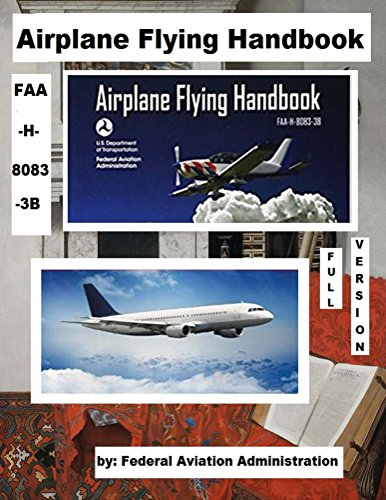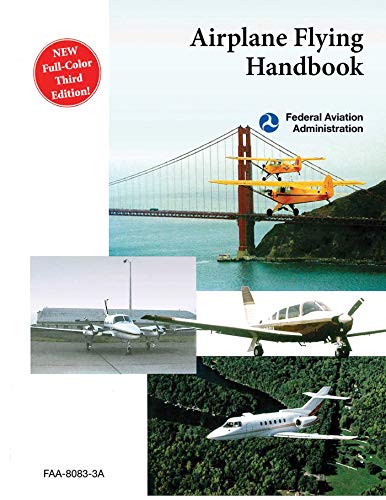-
Airplane Flying Handbook
Federal Aviation Administration
eBook (, May 30, 2017)The Airplane Flying Handbook provides basic knowledge that is essential for pilots. This handbook introduces basic pilotTable of Contents Chapter 1: Introduction to Flight Training Chapter 2: Ground Operations Chapter 3: Basic Flight Maneuvers Chapter 4: Maintaining Aircraft Control: Upset Prevention and Recovery Training Chapter 5: Takeoffs and Departure Climbs Chapter 6: Ground Reference Maneuvers Chapter 7: Airport Traffic Patterns Chapter 8: Approaches and Landings Chapter 9: Performance Maneuvers Chapter 10: Night Operations Chapter 11: Transition to Complex Airplanes Chapter 12: Transition to Multiengine Airplanes Chapter 13: Transition to Tailwheel Airplanes Chapter 14: Transition to Turbopropeller-Powered Airplanes Chapter 15: Transition to Jet-Powered Airplanes Chapter 16: Transition to Light Sport Airplanes (LSA) Chapter 17: Emergency Procedures
-
Airplane Flying Handbook: FAA-H-8083-3B
Federal Aviation Administration
Paperback (CreateSpace Independent Publishing Platform, May 19, 2018)The Airplane Flying Handbook provides basic knowledge that is essential for pilots. This handbook introduces basic pilot skills and knowledge that are essential for piloting airplanes. It provides information on transition to other airplanes and the operation of various airplane systems. It is developed by the Flight Standards Service, Airman Testing Standards Branch, in cooperation with various aviation educators and industry. This handbook is developed to assist student pilots learning to fly airplanes. It is also beneficial to pilots who wish to improve their flying proficiency and aeronautical knowledge, those pilots preparing for additional certificates or ratings, and flight instructors engaged in the instruction of both student and certificated pilots. It introduces the future pilot to the realm of flight and provides information and guidance in the performance of procedures and maneuvers required for pilot certification. Topics such as navigation and communication, meteorology, use of flight information publications, regulations, and aeronautical decision making are available in other Federal Aviation Administration (FAA) publications.
-
Airplane Flying Handbook, FAA-H-8083-3B
Federal Aviation Administration
eBook (, May 29, 2018)Airplane Flying HandbookFront Matter Table of Contents Chapter 1: Introduction to Flight Training Chapter 2: Ground Operations Chapter 3: Basic Flight Maneuvers Chapter 4: Maintaining Aircraft Control: Upset Prevention and Recovery Training (PDF)Chapter 5: Takeoffs and Departure Climbs Chapter 6: Ground Reference Maneuvers Chapter 7: Airport Traffic Patterns Chapter 8: Approaches and Landings Chapter 9: Performance Maneuvers Chapter 10: Night Operations Chapter 11: Transition to Complex Airplanes Chapter 12: Transition to Multiengine Airplanes Chapter 13: Transition to Tailwheel Airplanes Chapter 14: Transition to Turbopropeller-Powered Airplanes Chapter 15: Transition to Jet-Powered Airplanes Chapter 16: Transition to Light Sport Airplanes (LSA) Chapter 17: Emergency Procedures Glossary Index
-
Airplane Flying Handbook: FAA-H-8083-3A
Federal Aviation Administration, David Soucie
eBook (Skyhorse, May 17, 2007)This official U.S. government guide to piloting aircraftcreated by the Federal Aviation Administrationis the essential resource for finding the knowledge and skills to fly all types of planes. It includes an introduction to flight training and official information on ground operations, basic flight maneuvers, slow flight, stalls and spins, takeoff and departure climbs, ground reference maneuvers, airport traffic patterns, approaches and landings, performance maneuvers, and night operations. Pilots will find information on transitioning from small aircraft to more complex airplanes, as well as detailed explanations of emergency procedures. Each topic is coupled with colorful, detailed illustrations to aid the reader. Any pilot who wishes to maintain a current understanding of aircraft operation must read this book.
-
Airplane Flying Handbook
Federal Aviation Administration
eBook (Skyhorse, Sept. 11, 2011)The Federal Aviation Administration’s Airplane Flying Handbook provides pilots, student pi-lots, aviation instructors, and aviation specialists with information on every topic needed to qualify for and excel in the field of aviation. Topics covered include: ground operations, cockpit management, the four fundamentals of flying, integrated flight control, slow flights, stalls, spins, takeoff, ground reference maneuvers, night operations, and much more. The Airplane Flying Handbook is a great study guide for current pilots and for potential pilots who are interested in applying for their first license. It is also the perfect gift for any aircraft or aeronautical buff.
-
Airplane Flying Handbook
U.S. Department of Transportation, Federal Aviation Administration
Paperback (CreateSpace Independent Publishing Platform, Dec. 11, 2016)The “Airplane Flying Handbook” (FAA-H-8083-3B – 2016) provides basic knowledge that is essential for pilots. This handbook introduces basic pilot skills and knowledge that are essential for piloting airplanes. It provides information on transition to other airplanes and the operation of various airplane systems. It is developed by the Flight Standards Service, Airman Testing Standards Branch, in cooperation with various aviation educators and industry. This handbook is developed to assist student pilots learning to fly airplanes. It is also beneficial to pilots who wish to improve their flying proficiency and aeronautical knowledge, those pilots preparing for additional certificates or ratings, and flight instructors engaged in the instruction of both student certificated pilots. It introduces the future pilot to the realm of flight and provides information and guidance in the performance of procedures and maneuvers required for pilot certification.
-
Airplane Flying Handbook
Federal Aviation Administration, U. S. Department of Transportation, Flight Standards Service
Hardcover (Books Express Publishing, Sept. 30, 2012)Illustrated in full color throughout. The Airplane Flying Handbook is designed as a technical manual to introduce basic pilot skills and knowledge that are essential for piloting airplanes. It provides information on transition to other airplanes and the operation of various airplane systems. It is developed by the Flight Standards Service, Airman Testing Standards Branch, in cooperation with various aviation educators and industry. This handbook is developed to assist student pilots learning to fly airplanes. It is also beneficial to pilots who wish to improve their flying proficiency and aeronautical knowledge, those pilots preparing for additional certificates or ratings, and flight instructors engaged in the instruction of both student and certificated pilots. It introduces the future pilot to the realm of flight and provides information and guidance in the performance of procedures and maneuvers required for pilot certification. Topics such as navigation and communication, meteorology, use of flight information publications, regulations, and aeronautical decision making are available in other Federal Aviation Administration (FAA) publications.
-
Airplane Flying Handbook, FAA-H-8083-3B
Federal Aviation Administration
Paperback (CreateSpace Independent Publishing Platform, May 3, 2017)Table of Contents Chapter 1: Introduction to Flight Training Chapter 2: Ground Operations Chapter 3: Basic Flight Maneuvers Chapter 4: Maintaining Aircraft Control: Upset Prevention and Recovery Training Chapter 5: Takeoffs and Departure Climbs Chapter 6: Ground Reference Maneuvers Chapter 7: Airport Traffic Patterns Chapter 8: Approaches and Landings Chapter 9: Performance Maneuvers Chapter 10: Night Operations Chapter 11: Transition to Complex Airplanes Chapter 12: Transition to Multiengine Airplanes Chapter 13: Transition to Tailwheel Airplanes Chapter 14: Transition to Turbopropeller-Powered Airplanes Chapter 15: Transition to Jet-Powered Airplanes Chapter 16: Transition to Light Sport Airplanes (LSA) Chapter 17: Emergency Procedures
-
Airplane Flying Handbook
Federal Aviation Administration
Paperback (Skyhorse, Sept. 1, 2011)The Federal Aviation Administration’s Airplane Flying Handbook provides pilots, student pi-lots, aviation instructors, and aviation specialists with information on every topic needed to qualify for and excel in the field of aviation. Topics covered include: ground operations, cockpit management, the four fundamentals of flying, integrated flight control, slow flights, stalls, spins, takeoff, ground reference maneuvers, night operations, and much more. The Airplane Flying Handbook is a great study guide for current pilots and for potential pilots who are interested in applying for their first license. It is also the perfect gift for any aircraft or aeronautical buff. X
X
-
Airplane Flying Handbook
U. S. Department of Transportation, Federal Aviation Adminstration
Paperback (CreateSpace Independent Publishing Platform, June 11, 2013)The Airplane Flying Handbook is designed as a technical manual to introduce basic pilot skills and knowledge that are essential for piloting airplanes. It provides information on transition to other airplanes and the operation of various airplane systems. It is developed by the Flight Standards Service, Airman Testing Standards Branch, in cooperation with various aviation educators and industry. This handbook is developed to assist student pilots learning to fly airplanes. It is also beneficial to pilots who wish to improve their flying proficiency and aeronautical knowledge, those pilots preparing for additional certificates or ratings, and flight instructors engaged in the instruction of both student and certificated pilots. It introduces the future pilot to the realm of flight and provides information and guidance in the performance of procedures and maneuvers required for pilot certification. Topics such as navigation and communication, meteorology, use of flight information publications, regulations, and aeronautical decision making are available in other Federal Aviation Administration (FAA) publications. This handbook conforms to pilot training and certification concepts established by the FAA. There are different ways of teaching, as well as performing flight procedures and maneuvers, and many variations in the explanations of aerodynamic theories and principles. This handbook adopts a selective method and concept of flying airplanes. The discussion and explanations reflect the most commonly used practices and principles.
-
Airplane Flying Handbook: FAA-H-8083-3B
Federal Aviation Administration (FAA)
Paperback (Independently published, Jan. 27, 2019)The FAA’s Airplane Flying Handbook has been required reading for all pilots for over 40 years, and introduces the basic pilot skills and knowledge essential for piloting airplanes. It benefits student pilots just beginning their aviation endeavors, as well as pilots preparing for additional certificates and ratings or who want to improve their flying proficiency, and flight instructors engaged in teaching pilots of all skill levels. This handbook provides information and guidance on the procedures and maneuvers required for pilot certification. Chapters are dedicated to ground operations, basic flight maneuvers, slow flight, stalls, spins, takeoff and departure climbs, performance and ground reference maneuvers, airport traffic patterns, approaches and landings, flight training basics, transitions to different types of aircraft, emergency procedures, and much more. The latest edition expands and updates the material that has always been a key reference in the FAA’s testing and Airman Certification Standards (ACS), and it incorporates new areas of safety concerns and technical information such as loss-of-control upset prevention and recovery training, and transitioning to light sport airplanes (LSA). The Airplane Flying Handbook is the official FAA source for learning to fly and for many of the test questions in the FAA Knowledge Exams for pilots. Complete with chapter summaries and illustrated throughout with detailed, full-color drawings and photographs, it also includes a glossary and index.
-
Airplane Flying Handbook
Federal Aviation Administration
Paperback (Independently published, Oct. 15, 2018)MOST CURRENT VERSION as of 2019! Don't buy an old version! Rules and Regulations have changed. A must read for every pilot! The Airplane Flying Handbook provides basic knowledge that is essential for pilots. This handbook introduces basic pilot skills and knowledge that are essential for piloting airplanes. It provides information on transition to other airplanes and the operation of various airplane systems. It is developed by the Flight Standards Service, Airman Testing Standards Branch, in cooperation with various aviation educators and industry. This handbook is developed to assist student pilots learning to fly airplanes. It is also beneficial to pilots who wish to improve their flying proficiency and aeronautical knowledge, those pilots preparing for additional certificates or ratings, and flight instructors engaged in the instruction of both student and certificated pilots. It introduces the future pilot to the realm of flight and provides information and guidance in the performance of procedures and maneuvers required for pilot certification. Topics such as navigation and communication, meteorology, use of flight information publications, regulations, and aeronautical decision making are available in other Federal Aviation Administration (FAA) publications.Occasionally the word “must” or similar language is used where the desired action is deemed critical. The use of suchlanguage is not intended to add to, interpret, or relieve a duty imposed by Title 14 of the Code of Federal Regulations (14CFR).It is essential for persons using this handbook to become familiar with and apply the pertinent parts of 14 CFR and theAeronautical Information Manual (AIM). The AIM is available online at www.faa.gov. The current Flight StandardsService airman training and testing material and learning statements for all airman certificates and ratings can be obtainedfrom www.faa.gov. Illustrations note: Illustrations, black and white